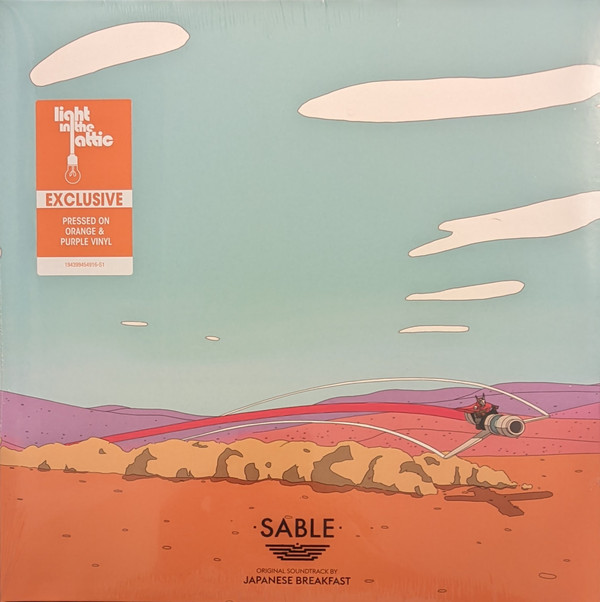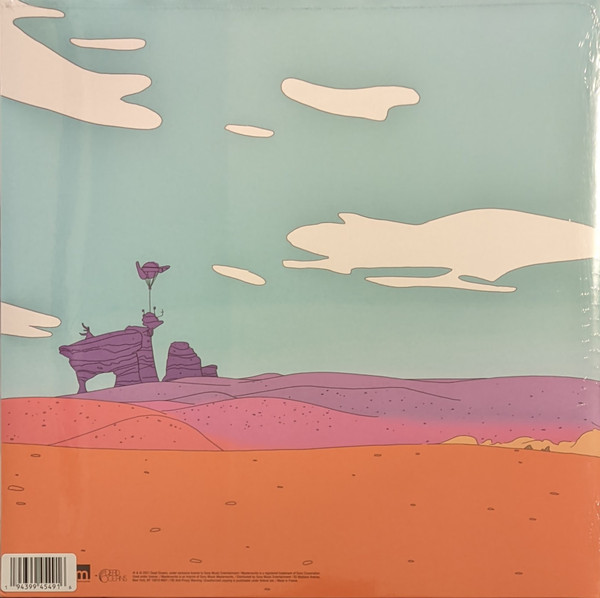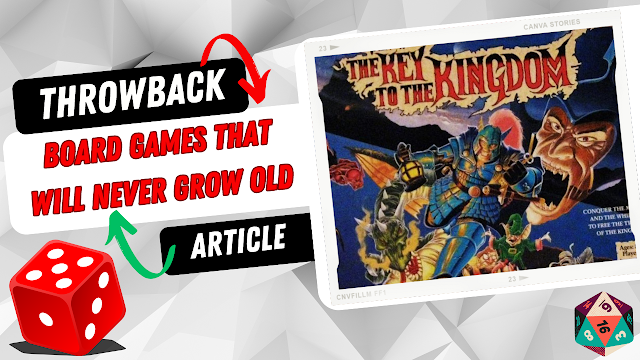Sony Music Masterworks / Dead Oceans
Nominated at the Golden Joystick Awards 2021 for best audio, Japanese Breakfast (Michelle Zauner) has created a soundtrack that captures the stark, expansive atmosphere of the game on which it was based – Shedworks’ 2021 hit, Sable. The soundtrack is in turn soaring, beautiful, thoughtful, and introspective as the thirty-two tracks unfold their audio narrative.
When I first received Sable for review, I had only heard of Japanese Breakfast in name only, and so had no preconceptions of the style or approach they would bring to a video game soundtrack, with the Wikipedia description of their genre as ‘alternative pop’ leaving a lot of room for interpretation.
Opting against listening to any of their music from outside of this soundtrack, I dived straight in* and the dreamy, atmospheric and often hypnotic sounds quickly won my heart.
Presented on a double gatefold cover, the imagery captured really does reflect the sounds within. Drawn in a fine-lined graphic novel art style that calls to mind the works of Belgian cartoonist Hergè.
Sable herself is gliding along the dusty sands, speed lines and clouds of dust in her wake as she arcs gracefully across the ground. Two-thirds of the cover is taken up by clear blue skies, a further hint as to that sense of openness and explorative promise that the audio synchronises with.
Opening up the cover and looking at the back reveals the image to be expanded across both halves of the gatefold, with Sable’s dust tracks trailing off over a hill, behind which are purple dunes and rocky outcrops, this would very clearly make a beautiful, framed landscape, a high five to Greg Kythreotis.
Opening up the inside of the cover shows a night-time scene that echoes the front of the vinyl. Sable skittering off into the distance, the same dust cloud and ever-present speed trail behind her, dominated by heavy blues, and completed by a sky dotted with stars. The chosen font that makes up the credits and tracklist is tastefully small and clean, so as not to impose upon the main visual identity of the artwork.
The records themselves are pressed on gold-coloured vinyl and have inner circles that sport the masks collected in-game. The thirty-two audio tracks are split across two heavyweight vinyl, and the soundtrack is laid out into four separate parts; Cities & Songs; Ruins, Forests & Insects; Biomes; Themes & Cut Scenes.
Beginning with three tracks with full vocals, the vast majority of the album is instrumental, with only snippets of occasional vocalisations. Before starting the track-by-track breakdown, I wanted to say that I’ve mentioned before how I struggle occasionally with lyrics in video game soundtracks being teeth-grindingly on the nose, but the work of Japanese Breakfast here is a masterclass in the power of words and how evocative they can be when used carefully, especially when they are delivered as they are here, with breathy, wide-eyed innocence.
Disc 1 Side A: Cities & Songs:
Main Menu – Slow piano kicks the album off, before the vocals come in, expressive and charming, with a plucked acoustic guitar following the melodies underneath. A short track at around a minute, this sets the tone and scene.
Glider – Quicker keyboard notes tinkle into play as single, high bass notes ring out over egg-shaker percussion, the production of the vocals gives an ethereal quality. Heavy, distant thudding bass drum and looped vocalisations really give the sense of flight here, especially in the latter half of the song where the vocals soar. An early single off the soundtrack, it’s easy to see why this was chosen, it has a soft and yet firm power to it.
Better the Mask – Back to a more stripped-down piano sound for this, the third song on the album. Piano melodies that twirl around each other, accompanied by aching violin and again, that breathy innocent vocal delivery really connects with expressive lyrics such as ‘and if in time, you find that you’ve doubled back / learn to rely on a future you made/ in which it gets better’ – it’s hard not to get swept up in the almost casual grandeur of it all.
The Ewer (Day) – The first track that eschews lyrics to fully focus on more environmental music, hand-played drums, wooden block and a simple rising/ falling synth rhythm set the foundations for an idiosyncratic keyboard sound effect that feels almost Amiga-like in its design, a sort of fake vocalisation that joins with the flute to create a mellow Eastern vibe. The setup of an oft-repeated melody with a handful of layers drifting over the top very much makes up the backbone of the album and this is a perfect example of what to expect going forwards. The cherry here being the soft guitar line that sees the song out.
The Ewer (Night) – An acoustic guitar strung with nylon strings rings out, rich with reverb. A reverberating bass string plays out underneath a, easy-vibe melody backed by a simple percussive beat that is joined by a rising choral vocal. It was here that I began to realise how well-suited the production is, reverb is everywhere and listening feels like being wrapped in warm cotton wool. Nothing is challenging or raw, it’s all designed to lull you into a sense of relaxation, very pretty stuff that absolutely suits the laid-back and often subtle compositions that make up the album.
Eccria (Day) – Bubbly synth and what appears to be an electronic pungi sound rise from slightly more unusual percussion here, swapping the soft, delicacy of the previous tracks for something that wouldn’t feel out of place on a Tomas Dvorak soundtrack. It works well thematically though, and with the reverb downplayed, the more metallic percussion and intertwining rhythms feel punchier and alert as opposed to calming and drowsy.
Eccria (Night) – That rich, punchy percussion is pushed right up front here, the production on the simple, hypnotic drum rhythm is glorious, it’s almost like it’s in the room with you! That forlorn pungi sound again bleeds out a melody over the top, as the atmospheric rattles and egg shaker made me think of a stoned, contented snake charmer chilling out at night on a hillside beside a fire, very evocative. Certainly, the sparsest song so far, and beautifully so.
Campfires – This begins with atmospheric sounds as a plucked guitar repeats a melody. Soon joined by a brighter layer of guitar, the mood of Eccria (Night) is continued, but this feels more like the music that plays as your thoughts float strangely into sleep, a brief and pretty track.
Disc 1 Side B: Ruins, Forests & Insects
Exploration (Ships) – ‘80s waves of synth combined with electronica kick off the second side of the album, a much more ominous tone than the one set on side A. Soon, an echoing tribal drum beat cuts through, this feels like someone exploring a wet cave, not afraid - but certainly unsure, the pulses of wiry electronica standing out, giving a sense of something not belonging.
Exploration (Ruins) – The airy synth vibe continues, but this is far more melancholic and less threatening. From the title, you can very much imagine this being the soundtrack to someone gazing up on a grassy plain at the remnants of a lost civilisation, the monolithic structures seeming incomprehensible. One of the longer songs on the album, the almost whale song-like notes that float and breeze through the track and meld with rare, breathy vocalisations put you in the mindset of nostalgic awe.
Exploration (Nature) – The first hint of a more upbeat tone subtly raises its head here, a softly galloping, grassy beat and electronica that reminded me faintly of the sort used throughout Pixeljunk Monsters idiosyncratically sings out, the oddness of the melody setting it apart from the previous couple of tracks. It’s ironic that, whilst the word ‘nature’ is in the song title, this feels like it belongs to an alien landscape. The final swirls a brief nod to the druggy soup of Hotline Miami.
Beetle’s Nest – The wonderful oddness continues here as a rising melody loops underneath a mournful oboe/clarinet. Upright bass gets a cheekily funky groove going as light percussion punctuates the beat. Soon, the clarinet comes back in at a higher octave, really lighting up the track.
Glow Worm Cave – A melody that shimmers like crystal eases this song in, to be joined by a soft and tubey bass line and higher-pitched layering to add depth and richness to the track, harking back to the sparseness of the first side. The squelchy synth that comes in at the denouement was pure 16-bit gold to my ears!
Pyrausta’s Ruin – The final track of the side features the same Amiga-like keyboard effect from the flip side but is more alien and unsettling here. Acting almost as an understated ‘boss theme’, the throaty electronic backbeat feels predator-like in its insistence. The ambient work that coats this side creeps along in the background. All in all, this is certainly a far darker mood than the preceding side! Yet, composed with a lightness of touch that makes it feel part of a whole theme as opposed to lurching from one style to the next. The way that melodies and effects will drift in and out, occasionally only being used once really keeps your ears alert and interested in how the tracks subtly evolve.
Disc 2 Side C: Biomes
Badlands (Night) – Muted, plucked strings and a whooshing wind begins the third side of the record, very much evocative of the Badlands of the title. Low, rumbling notes add an ache to the track as the layers play into each other, a return to that thick emotional ambience of the initial side of the record. Gentle single piano notes play out. A track very much set in the heart of a lonely night.
Hakoa – (Day) – Bass so thick that you could cut it with a knife actually brought goosebumps to my flesh here, the descending notes felt almost cyberpunk in their nature. The echoing, distant effects would have been at home on the Shadow of the Beast soundtrack, there’s a real emotional weight here that grabs your attention in a vice. I didn’t expect such a saucy turn into such an atmospheric bent but wow, what a powerful and extremely understated track. It could have been twenty minutes long and I wouldn’t have batted an eyelid.
Hakoa (Night) – A shivering two-note bass melody that sounds like it’s being played on an old portable cassette player with a failing tape acts as the foundation for some heart-rending piano descension. The entire track feels like it’s got a tape loop effect running through, adding fragility and emotional core to it. When the backward samples rolled in, I was starting to think that this could be my favourite side, there’s so much to take in here, moments that pull at your heartstrings whilst others pull at your soul and again, all so, so understated.
Sansee – (Day) – A wavering, rich and clean electric (baritone?) guitar plays out a five-note melody, pushed right to the fore, as keening electronic melodies ring out behind it, dancing with short piano runs, the last three songs here really roll together well - kudos to the production - as, with the hand drums in an earlier song, it’s so organic that it feels as if the guitar could be being playing right in front of you if you closed your eyes.
Sansee (Night) – Piano notes with an almost uncomfortably long wait between them - as if the person playing can barely bring themselves to move - very much continue the slow descent into melancholy on side C. I thought that Sansee (Day) was minimalist, but here – left alone with an almost weeping piano and occasional breaths of flute – we learn what crafted minimalism really is.
Redsee (Day) – The egg shaker returns to lift things up with some light percussion, as notes that feel like heat shimmers on the horizon rise up and that richly clean guitar again plays a handful of notes, this time embellished with an octave pedal. A song that feels like someone waking up on a warm morning. The guitar slides and runs in this are pure, shining gold. Simple and effective as ever, they really add character and a human touch to the track.
The Wash (Day) – Following on from Redsee (Day); the four-note, wavering melody that runs through this is accentuated by a gliding recorder line that weaves a dainty tune across the top. As electronic drums kick back in, anchoring that four-note melody, it feels like this side of the album has taken place through the night, the last two songs acting as the waking / morning sections. I think this side has been my favourite so far, moving, textured and almost addictive in the atmospheric approach.
Disc 2 Side D: Themes & Cut Scenes
Chum Lair – A pretty flute melody and a return to traditional drums follow on and continue the bright, sunshine-laden theme. When I first saw the title of ‘Chum Lair’ I assumed this would be a boss theme-styled track, but I was very wrong!
Beetle Detour – Higher flute here and a chittering percussive beat over a repeated mandolin melody, the blends of traditional and electronic instrumentation are very much a theme of this side so far, with two tunes that have a real innocent charm to them reeling us in.
Machinist’s Theme – Wow, a second song that gives me the ‘Pixeljunk Monsters’ vibe! Again, very innocent, light beats that feel welcoming and harmless, music that actually sounds like an open, all-embracing smile to all. Beautiful.
Cartographer’s Theme – A parping, big ‘n silly theme for the Cartographer! The accordion gives a sea shanty shine to everything. There really is a huge array of instrumentation on display throughout this album! Shortly moving into a pacey cello theme, it’s appearing that the final side embraces the inner child with whimsical themes and style.
Mask Caster’s Theme – What I can only describe as sounding between a pungi and a theremin plays Eastern-inflected melodies over bells and a simple, looping electro-beat. The Mask Caster is certainly a person of intense spirituality and mystery.
Mischievous Children – A busier percussion and reverb-laden flute here hint at the atmospherics of previous tracks but still have that innocent charm that seemingly runs through this entire side of the record (good!). The percussion feels like the pitter-patter of naughty feet, as the title suggests.
Ibexxi Camp (Day) – An early favourite, the chorus-effected guitar that underpins the Spanish-style nylon strings that play lead runs across the top really resonated with me, it’s peaceful and calming, almost like the song knows it’s at the end of an album and is here to play us out, I love this one.
Ibexxi (Night) – very much a reflection of the prior track, the two plucked guitar chords that makeup Ibexxi (Night) are accentuated by a passing synth that feels like a distant ship in the background as a lighthouse beacon silently whips across the landscape. The nakedness in how the strings are played feels somehow exposed, and the delicate runs only enhance this feeling.
Burnt Oak Station (Day) – A really engaging and repeating guitar motif in backed by a woody, naked bass played by hand. The organic and human element of this side seems to be becoming more prominent as if the journey is nearing its end and now we are coming back to solid ground, back to what we know - and are comfortable with, and it’s gorgeous – much like the music from Animal Crossing: New Horizons, this feels timeless, like I could listen to it for hours.
Burnt Oak Station (Night) – As with Ibexxi Camp Day and Night, this is a reflection of Burnt Oak Station, but in a very literal way. Made up of the same melodies, the bass remains almost identical but the guitar seems to have been run through a tape loop to give it that shimmering, wavering quality. The rawness of the piano that echoes the second guitar track of the ‘Day’ cycle acts as a really clever and mesmerising way to lead us out of the album, revisiting melodies like we are reflecting on memories, experiences and lessons learned.
Abandoned Grounds - The final track of the album, Abandoned Grounds is comprised of a heart-breaking keyboard melody that joins with airy and yet moody ambient sounds that hint at a darker ending to our tale than perhaps the dual ‘Burnt Oak Stations’ tracks have led us to believe. It’s a coda that surprised me, a sneaky track that introduced a slowly growing intense melancholy (good), is everything ok?
This is a soundtrack that may not reveal itself upon the first few listens, and the occasional minimalism and sparseness of certain tracks may make you unconsciously wait for something else to be added or kick in.
For me, it is a soundtrack that very much rewards repeat listens and got its claws deeper into me the more time that I spent with it, the aural shape and construction of each side really does feel like a cohesive journey and gently swerves from tribal instrumentation to jaunty feel-good moments and sections of real darkness and intensity, but never resorts to shock value.
*When I first listened to the first side of Sable, I was baffled as it seemed pretty avant-garde and oddly intense, it was only when I realised that my one-year-old son had altered the speed of my turntable from 33rpm to 45rpm behind my back that I realised what had happened!









Hello, everyone! Right now, I'm on the lookout for a qualitative psychology dissertation. While you're waiting, The artwork created on the double gatefold cover truly reflects the sounds within. Drawn in a fine-lined graphic book art style reminiscent of Belgian cartoonist Herger's work. This is a fantastic article. Thank you for providing this useful blog.
ReplyDelete